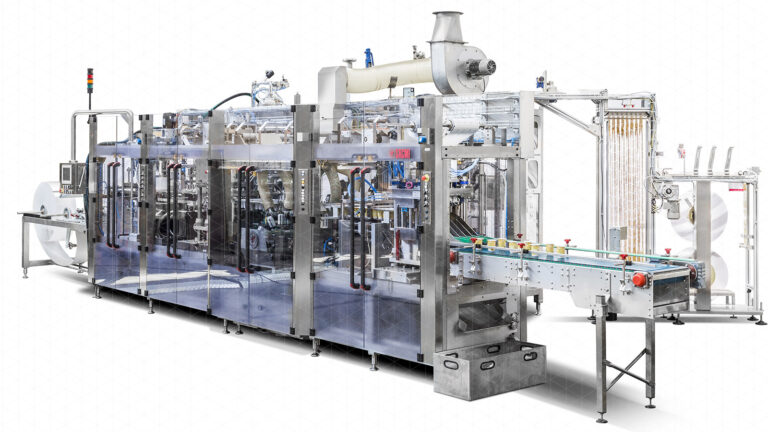In 2022, the form fill seal equipment market was valued at nearly US$ 8.4 billion and is forecasted to reach US$ 13.7 billion by the end of the projection period in 2032. Worldwide sales of form fill seal equipment are expected to increase at a rate of 5% during this period. This growth trajectory highlights the widespread adoption of form fill seal technology across various industries for efficient and automated packaging solutions. The market’s expansion underscores the continuous demand for streamlined packaging processes and the pursuit of enhanced productivity and cost-effectiveness in manufacturing operations.
The form fill seal equipment market is regionally segmented into five key regions: North America, Asia Pacific, Europe, Latin America, and the Middle East and Africa (MEA). Notably, the North America form fill seal market segment stands as a dominant force within the global market for form fill seal equipment. This leadership position is attributed to the region’s consistent advancements in engineering and manufacturing industries, which have fostered innovation and efficiency in packaging processes.
Together, the North America and Europe markets collectively account for more than one third of the global form fill seal equipment market. However, the Latin American region shows promising potential in terms of growth. As engineering and manufacturing capabilities continue to expand in Latin American countries, it is expected to create investment opportunities for market players operating in the form fill seal equipment market. This highlights a shift in focus toward emerging markets with the capacity for substantial growth and technological development within the industry.
Request Sample: https://www.futuremarketinsights.com/reports/sample/rep-gb-3510
Business Growth Drivers:
- Increasing Demand for Packaged Goods: With growing urbanization and changing lifestyles, there’s a rising demand for packaged goods across various sectors, driving the need for efficient packaging solutions like FFS equipment.
- Advancements in Packaging Technology: Technological advancements in FFS equipment, such as improved automation, precision, and versatility, are attracting businesses looking to optimize their packaging processes for higher productivity and quality.
- Focus on Sustainable Packaging: The shift towards sustainable packaging solutions due to environmental concerns is propelling the demand for FFS equipment that can utilize eco-friendly materials and minimize packaging waste.
- Rising Adoption of Flexible Packaging: Flexible packaging formats, such as pouches and sachets, are gaining popularity due to their convenience and cost-effectiveness, driving the demand for FFS equipment tailored for such applications.
- Expanding Food and Beverage Industry: The growth of the food and beverage industry, particularly in emerging markets, is a significant driver for the FFS equipment market as manufacturers seek efficient packaging solutions to meet increasing consumer demand.
- Stringent Regulations: Regulatory requirements regarding packaging quality, safety, and hygiene standards are encouraging companies to invest in modern FFS equipment that complies with industry regulations, thus driving market growth.
- Increasing Focus on Operational Efficiency: FFS equipment offers advantages such as faster packaging speeds, reduced labor costs, and minimized material wastage, making it an attractive investment for companies aiming to enhance their operational efficiency and competitiveness.
Industry Restraints:
- High Initial Investment Costs: The upfront costs associated with purchasing and installing FFS equipment can be substantial, particularly for small and medium-sized enterprises (SMEs), posing a barrier to entry for some businesses.
- Complexity of Equipment Operation: FFS equipment often involves complex machinery and processes, requiring skilled operators and specialized training, which can increase operational costs and pose challenges for companies lacking adequate expertise.
- Maintenance and Downtime Concerns: Regular maintenance and occasional downtime for equipment servicing can disrupt production schedules and impact overall efficiency, prompting concerns among businesses regarding the reliability and upkeep costs of FFS machinery.
- Compatibility Issues with Packaging Materials: Certain types of FFS equipment may have limitations regarding the compatibility with specific packaging materials or formats, restricting the flexibility and versatility of packaging options for manufacturers.
- Competition from Alternative Packaging Solutions: FFS equipment faces competition from alternative packaging technologies, such as pre-formed containers and traditional packaging methods, which may offer advantages in certain applications or industries, limiting market growth potential in those segments.
- Supply Chain Disruptions and Market Volatility: Factors such as raw material shortages, geopolitical tensions, and economic uncertainties can lead to supply chain disruptions and market volatility, impacting the investment decisions and expansion plans of businesses in the FFS equipment market.
- Limited Adoption in Certain Regions: In some regions, particularly developing countries with underdeveloped packaging infrastructure and low awareness of advanced packaging technologies, the adoption of FFS equipment may be limited, constraining market growth opportunities in those areas.
Key Players
Some of the major players of form fill seal equipment market are
- Ossid LLC,
- Matrix Packaging Machinery LLC,
- All-Fill Inc.,
- Robert Bosch GmbH,
- General Packaging Company,
- Viking Masek Global Packaging Technologies,
- Primier Tech Chronos
- Nichrome India Ltd.
The report offers an accurate evaluation of the market through detailed qualitative insights and verifiable projections about market size. The projections presented in the report have been derived using proven research methodologies and assumptions.
Buy Now/Purchase: https://www.futuremarketinsights.com/checkout/3510
Form Fill Seal Equipment Market
On the basis of application, the form fill seal equipment market can be segmented into
- food & beverage
- cosmetics
- electronics
- stationary
- pharmaceuticals
- chemicals
- others (tobacco and medical)
About Future Market Insights (FMI)
Future Market Insights, Inc. (ESOMAR certified, recipient of the Stevie Award, and a member of the Greater New York Chamber of Commerce) offers profound insights into the driving factors that are boosting demand in the market. FMI stands as the leading global provider of market intelligence, advisory services, consulting, and events for the Packaging, Food and Beverage, Consumer, Technology, Healthcare, Industrial, and Chemicals markets. With a vast team of over 5000 analysts worldwide, FMI provides global, regional, and local expertise on diverse domains and industry trends across more than 110 countries.
Contact Us:
Future Market Insights Inc.
Christiana Corporate, 200 Continental Drive,
Suite 401, Newark, Delaware – 19713, USA
T: +1-845-579-5705
For Sales Enquiries: sales@futuremarketinsights.com
Website: https://www.futuremarketinsights.com
LinkedIn| Twitter| Blogs | YouTube





